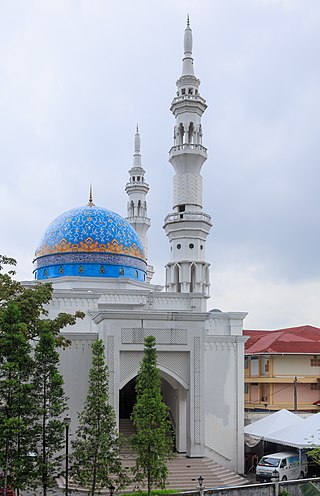Related Research Articles

The National Mosque of Malaysia is a mosque in Kuala Lumpur, Malaysia. It has a capacity for 15,000 people and is situated among 13 acres (53,000 m2) of gardens. Its key features are a 73-metre-high (240 ft) minaret and a 16-pointed star concrete main roof. The umbrella, synonymous with the tropics, is featured conspicuously – the main roof is reminiscent of an open umbrella, the minaret's cap a folded one. The folded plates of the concrete main roof are a creative solution to achieving the larger spans required in the main gathering hall. Reflecting pools and fountains are spread throughout the compound. Completed in 1965, the mosque is a bold and modern approach in reinforced concrete, symbolic of the aspirations of a then newly independent nation.

The Ubudiah Mosque is a small mosque located in the royal town of Kuala Kangsar, Perak, Malaysia.

Mutiara Rini is a housing area and suburb in Skudai, Johor, Malaysia. It is developed by Mutiara Rini Sdn Bhd, a subsidiary of the military-linked Boustead Group.

The As Syakirin Mosque, also known as KLCC Mosque, is a mosque located in the Kuala Lumpur City Centre, Kuala Lumpur, Malaysia. The mosque is situated near the Suria KLCC shopping centre and the Petronas Twin Towers, the tallest twin towers in the world.

The Federal Territory Mosque is a mosque in Kuala Lumpur, Malaysia. It is located near MATRADE complex and the Federal Government Complex off Jalan Duta, in Segambut district.
The Saidina Abu Bakar As Siddiq Mosque (MSABA) is a prominent mosque in Bangsar, Kuala Lumpur, Malaysia. The mosque was named after Muhammad's successor (Caliph) Abu Bakr.
The Islamic Heritage Park is a famous attraction in Kuala Terengganu, Terengganu, Malaysia. This park is located at the island of Wan Man.

The Al-Bukhari Foundation Mosque is a mosque in Kuala Lumpur, Malaysia. It is adjacent to the Victoria Institution and opposite the Jalan Hang Tuah fire station and SP9 MR4 Hang Tuah LRT station.

Kampung Sungai Penchala is a small Malay village in the Segambut constituency in northwestern Kuala Lumpur, Malaysia, with the postcode 60000 KUALA LUMPUR, lying along the Federal Territory–Selangor border. This village is next to Taman Tun Dr Ismail in Kuala Lumpur, Malaysia which also shares the same 60000 KUALA LUMPUR postcode, and adjacent to Mutiara Damansara and Bandar Utama that were once part of a large oil palm plantation across the interstate border.

Sri Permaisuri is a township in Cheras, Kuala Lumpur, Malaysia. It is located near Bandar Tun Razak and Salak South. It was opened for residential housing in 2000. The major types of housing there are apartments and condominiums.
The Amru Al-As Mosque is a prominent mosque in Bandar Baru Sentul, Kuala Lumpur, Malaysia.
Al Akram Mosque is a mosque in Kampung Datuk Keramat, Kuala Lumpur, Malaysia.
Abdul Rahman Auf Mosque is a mosque in Kuala Lumpur, Malaysia. This mosque is located at Jalan Puchong near Jalan Klang Lama junctions.
The Imam Al Ghazali Mosque is a mosque in Kuala Lumpur, Malaysia. This mosque is located at Bandar Manjalara and was named after Imam Al-Ghazali, a Muslim philosopher.
Dato' Y. T. Lee, also Lee Yoon Thim was a Malaysian Chinese architect active in Kuala Lumpur in the 1950s and 1960s. He helped "Build Merdeka" after Malaysian Independence, 1963. He moved in elite circles, and held several positions in the national government and in the Chinese community. He was a close friend to Prime Minister Tuanku Abdul Rahman and other political figures. He designed several of Kuala Lumpur's landmark buildings, such as: Chin Woo Stadium, UMNO building, Dewan Bahasa dan Pustaka, Federal Hotel, Kampung Baru Mosque, Ar-Rahman Mosque and the Masjid Al-Ubudiyah. In addition to his famous mosques in Kuala Lumpur, he also worked on middle eastern and Islamic architecture project, for example, Masjid Al- Ubudiyah in Kerling, Hulu Selangor which is opened in 1960. When this masjid is built, there was no electricity supply yet. Somehow now it has been used as a teaching place by the locals. His less well known works include the Too House, an addition for the Methodist Boys School, and healthcare-related and commercial work. In the early 1960s, a series of honours came his way: in 1960, he was granted the appellation of P.J.K.; in 1961, he was honoured as Justice of Peace and J.M.N in 1962; he was honoured as Dato' in 1964, an honorific similar to the British "Sir".
The Saidina Umar Al Khattab Mosque (MSUAK) is a prominent mosque in Bukit Damansara, Kuala Lumpur, Malaysia.

The Al-Rahman Mosque is a mosque in Kuala Lumpur, Malaysia. The mosque is located at University of Malaya in Jalan Pantai Baharu and was named after the first Malaysian Prime Minister, Tunku Abdul Rahman Putra Al-Haj. Today, the mosque is joint managed by University of Malaya and the Department of Federal Territory Islamic Affairs (JAWI).

Jamek Mosque, officially Sultan Abdul Samad Jamek Mosque is one of the oldest mosques in Kuala Lumpur, Malaysia. It is located at the confluence of the Klang and Gombak rivers and may be accessed via Jalan Tun Perak. The mosque was designed by British architect and soldier Arthur Benison Hubback, and built in 1909. It was the principal mosque of Kuala Lumpur until the construction of the national mosque Masjid Negara in 1965.
Kampung Padang Balang or Padang Balang is the oldest surviving traditional village in Kuala Lumpur, Malaysia. It is circumferenced by Gombak Road, Jalan Kampung Bandar Dalam, Duta–Ulu Klang Expressway (DUKE), Kuala Lumpur Middle Ring Road 2 and Gombak River.
References
- ↑ "Masjid At-Taqwa TTDI". Archived from the original on 22 June 2018. Retrieved 3 November 2014.



